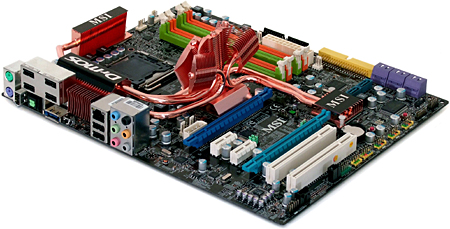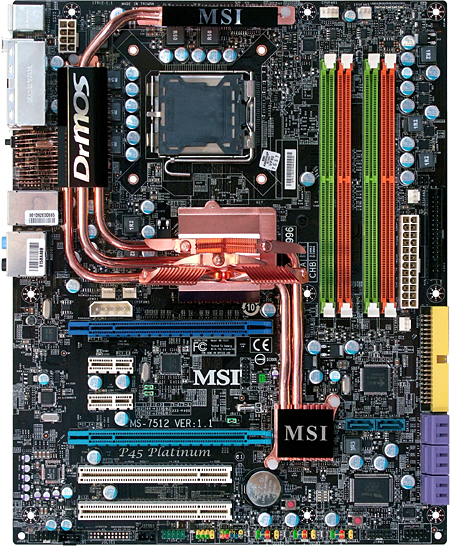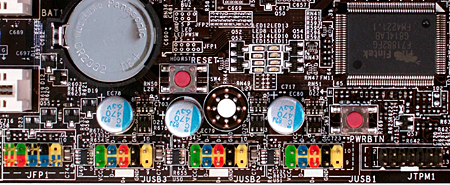11-Way P45 Motherboard Shootout
MSI P45 Platinum
MSI’s Platinum series represents high-end features at better-value pricing, and a starting price of around $175 for it P45 Platinum puts this model directly between the high-end and mainstream parts of other brands. That raises a question of whether the P45 Platinum is a better value competitor to high-end parts like the Asus P5Q Deluxe, or an upscale competitor to mainstream models such as the Biostar TPower i45. Let’s see if we can figure it out.
It appears MSI has given up on its Circu-Pipe chipset cooler design and gone with a more artistic style. Under those sinks are the P45 Express northbridge, ICH10R southbridge, and the transistors for a 6-phase CPU voltage regulator.
While all of the P45 Platinum’s key features can be found on a cheaper competitor’s motherboard, none of the sub-$150 boards have all of them. For example, only the Jetway HI04 has a six-phase voltage regulator, but Jetway doesn’t use the RAID-supporting ICH10R southbridge or provide IEEE-1394 FireWire. And while Jetway would appear to have a lead over MSI with its extra eSATA port, MSI has two additional internal SATA ports.
So is the P45 Platinum a more expensive alternative to the Jetway HI04, or is the HI04 a cheap knock-off of the MSI P45 Platinum ? A look back at Jetway’s rendition of MSI’s former “Circu-Pipe” cooler design could provide some insight, though Jetway has the singular advantage of its two-digit post-code display.
When it comes to connector placement however, MSI has a huge lead over cheaper competitors. Eight-pin and 24-pin power connectors are almost ideally located at the top rear corner and front edge, the floppy connector is located directly behind the place where most tower cases have a 3.5” external bay, and the Ultra ATA connector is only a little low on the front edge for somewhat easy cable routing to the upper bays of mid-tower cases. This combination pits the P45 Platinum directly against ultra expensive competition like the Asus Maximus II Formula.
Like the Maximus II Formula, the P45 Platinum has the distinction of six forward-facing Serial ATA ports that could be blocked by the hard drive cages of some cases, and two additional upward-facing ports. Graphics card clearance is the reason for pointing those six ports forward, and when placed into a properly laid-out case, either model will allow a full set of drive cables to be installed. MSI has the advantage of separate three-gigabit pathways for its added ports, while Asus’ disadvantage is a side-effect of the otherwise highly-praised SteelVine port multiplier.
There are a few things that prevent MSI from competing directly on price alone with the Maximus II Formula however, as the Asus model has an audio riser card with a claimed increase in audio clarity, and added slot that can service either PCI Express x1 cards or the audio riser card, an externally-mounted diagnostics display module, dual BIOS, and—for those who care about such things—more bling.
Get Tom's Hardware's best news and in-depth reviews, straight to your inbox.
MSI doesn’t just lack lights under its power and reset buttons, it doesn’t even put shiny covers on them. Not that this matters to us, but it’s sure to affect the buying decisions of those whose tastes are a little more flamboyant. Beneath the buttons are three USB headers to support a combination of six USB 2.0 ports and bay devices.
So is the P45 Platinum a premium alternative to mainstream motherboards, or a less-expensive alternative to high-end parts ? Neither. For today’s review the P45 Platinum owns the $150-200 segment, as it competitors have provided no similarly-priced products to compare it to.
Current page: MSI P45 Platinum
Prev Page HI04 Software And Accessories Next Page P45 Platinum Onboard Devices-
nickchalk Where are the lower price P45 M/B ?Reply
Asus P5Q pro is out for €110 and P5Q deluxe for €165 the price difference is about 70$ in Greece. -
Proximon I suppose I can get some good from having read this. Did you get paid by the word? Maybe next time you could just put together a complete features chart so that we can have some convenient comparison? You know, so someone could go to a chart and see at a glance which boards had eSATA or firewire, or 8 USB.Reply
-
JPForums I'd rather have the overabundance of information than a lack of information. Presentation could use a little refining (I.E. comparison charts and the likes), but having the relevant information available at least is a good thing.Reply -
the introduction and specifics are nice, the comparision isn't. so, why don't you test with an 8500 or qx9650? 6850 are outdated... and a mobo handling a c2d doesn't mean it can handle a quad too, see P5K for example (it stinks when it comes to a q6600).Reply
-
Crashman procithe introduction and specifics are nice, the comparision isn't. so, why don't you test with an 8500 or qx9650? 6850 are outdated... and a mobo handling a c2d doesn't mean it can handle a quad too, see P5K for example (it stinks when it comes to a q6600).Reply
Tom's Hardware wants the performance of current articles to reflect that of recent articles, so a "standard test platform" was chosen a while ago. It will get updated, but probably not before the new socket becomes widely available. -
zenmaster I would have liked to see something such as a P35 and an X48 as controls to help analyze the P45 Performance.Reply
In otherwords, What is the P45 Gaining me over the older P35.
What would I gain by going to the X48. (Or Lose) -
Crashman zenmasterI would have liked to see something such as a P35 and an X48 as controls to help analyze the P45 Performance.In otherwords, What is the P45 Gaining me over the older P35.What would I gain by going to the X48. (Or Lose)http://www.tomshardware.com/reviews/intel-p45-chipset,1961.htmlReply -
johnbilicki The first 17 pages were filled with nothing but junk from ASUS. Do us a favor: don't even bother featuring or *MENTIONING* anything for any reason from a company that refuses to RMA 200-400 dollar brand new motherboards with anything other then used and usually broken junk. It destroyed my enthusiasm for the article.Reply -
dobby nickchalkWhere are the lower price P45 M/B ?Asus P5Q pro is out for €110 and P5Q deluxe for €165 the price difference is about 70$ in Greece.Reply
the p5q PRo is a p43 board, i should know i have one



